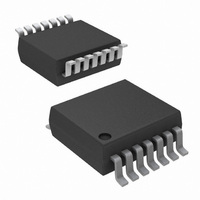ISL12023IVZ Intersil, ISL12023IVZ Datasheet - Page 19

ISL12023IVZ
Manufacturer Part Number
ISL12023IVZ
Description
IC RTC/CLDR TEMP SNSR 14-TSSOP
Manufacturer
Intersil
Type
Clock/Calendarr
Datasheet
1.ISL12023IVZ.pdf
(28 pages)
Specifications of ISL12023IVZ
Memory Size
1K (128 x 8)
Time Format
HH:MM:SS (12/24 hr)
Date Format
YY-MM-DD-dd
Interface
I²C, 2-Wire Serial
Voltage - Supply
2.7 V ~ 5.5 V
Operating Temperature
-40°C ~ 85°C
Mounting Type
Surface Mount
Package / Case
14-TSSOP
Lead Free Status / RoHS Status
Lead free / RoHS Compliant
Available stocks
Company
Part Number
Manufacturer
Quantity
Price
Company:
Part Number:
ISL12023IVZ
Manufacturer:
Intersil
Quantity:
341
ALARM Registers (10h to 15h)
The alarm register bytes are set up identical to the RTC
register bytes, except that the MSB of each byte functions as
an enable bit (enable = “1”). These enable bits specify which
alarm registers (seconds, minutes, etc.) are used to make
the comparison. Note that there is no alarm byte for year.
The alarm function works as a comparison between the alarm
registers and the RTC registers. As the RTC advances, the
alarm will be triggered once a match occurs between the
alarm registers and the RTC registers. Any one alarm register,
multiple registers, or all registers can be enabled for a match.
There are two alarm operation modes: Single Event and
periodic Interrupt Mode:
• Single Event Mode is enabled by setting the bit 7 on any
• Interrupt Mode is enabled by setting the bit 7 on any of
To clear a single event alarm, the ALM bit in the status
register must be set to “0” with a write. Note that if the ARST
bit is set to 1 (address 08h, bit 7), the ALM bit will
automatically be cleared when the status register is read.
Following are examples of both Single Event and periodic
Interrupt Mode alarms.
Example 1
• Alarm set with single interrupt (IM = “0”)
• A single alarm will occur on January 1 at 11:30 a.m.
• Set Alarm registers as follows:
REGISTER
ALARM
of the Alarm registers (ESCA0... EDWA0) to “1”, the IM bit
to “0”, and disabling the frequency output. This mode
permits a one-time match between the Alarm registers
and the RTC registers. Once this match occurs, the ALM
bit is set to “1” and the IRQ output will be pulled low and
will remain low until the ALM bit is reset. This can be done
manually or by using the auto-reset feature.
the Alarm registers (ESCA0... EDWA0) to “1”, the IM bit to
“1”, and disabling the frequency output. The IRQ output
will now be pulsed each time an alarm occurs. This means
that once the interrupt mode alarm is set, it will continue to
alarm for each occurring match of the alarm and present
time. This mode is convenient for hourly or daily hardware
interrupts in microcontroller applications such as security
cameras or utility meter reading.
MOA0
DWA0
MNA0
HRA0
SCA0
DTA0
7 6 5 4 3 2 1 0 HEX
0 0 0 0 0 0 0 0 00h Seconds disabled
1 0 1 1 0 0 0 0 B0h Minutes set to 30, enabled
1 0 0 1 0 0 0 1 91h Hours set to 11, enabled
1 0 0 0 0 0 0 1 81h Date set to 1, enabled
1 0 0 0 0 0 0 1 81h Month set to 1, enabled
0 0 0 0 0 0 0 0 00h Day of week disabled
BIT
19
DESCRIPTION
ISL12023
After these registers are set, an alarm will be generated when
the RTC advances to exactly 11:30 a.m. on January 1 (after
seconds changes from 59 to 00) by setting the ALM bit in the
status register to “1” and also bringing the IRQ output low.
Example 2
• Pulsed interrupt once per minute (IM = “1”)
• Interrupts at one minute intervals when the seconds
• Set Alarm registers as follows:
Once the registers are set, the following waveform will be
seen at IRQ:
Note that the status register ALM bit will be set each time the
alarm is triggered, but does not need to be read or cleared.
Time Stamp V
The TSV2B Register bytes are identical to the RTC register
bytes, except they do not extend beyond the Month. The Time
Stamp captures the FIRST V
time, and will not update upon subsequent events, until cleared
(only the first event is captured before clearing). Set CLRTS = 1
to clear this register (Add 09h, PWR_V
Note that the time stamp registers are cleared to all “0”,
including the month and day, which is different from the RTC
and alarm registers (those registers default to 01h). This is
the indicator that no time stamping has occurred since the
last clear or initial power-up. Once a time stamp occurs,
there will be a non-zero time stamp.
Time Stamp Battery to V
The Time Stamp Battery to V
to the RTC register bytes, except they do not extend beyond
Month. The Time Stamp captures the LAST transition of
V
REGISTER
BAT
register is at 30s.
ALARM
DWA0
MNA0
MOA0
SCA0
HRA0
DTA0
to V
D
RTC AND ALARM REGISTERS ARE BOTH “30s”
(only the last event of a series of power-up/down
7 6 5 4 3 2 1 0 HEX
1 0 1 1 0 0 0 0 B0h Seconds set to 30,
0 0 0 0 0 0 0 0 00h Minutes disabled
0 0 0 0 0 0 0 0 00h Hours disabled
0 0 0 0 0 0 0 0 00h Date disabled
0 0 0 0 0 0 0 0 00h Month disabled
0 0 0 0 0 0 0 0 00h Day of week disabled
FIGURE 13. IRQ WAVEFORM
DD
to Battery Registers (TSV2B)
BIT
DD
60s
DD
DD
to Battery Voltage transition
Register bytes are identical
Registers (TSB2V)
DD
enabled
register).
DESCRIPTION
June 24, 2009
FN6682.2












